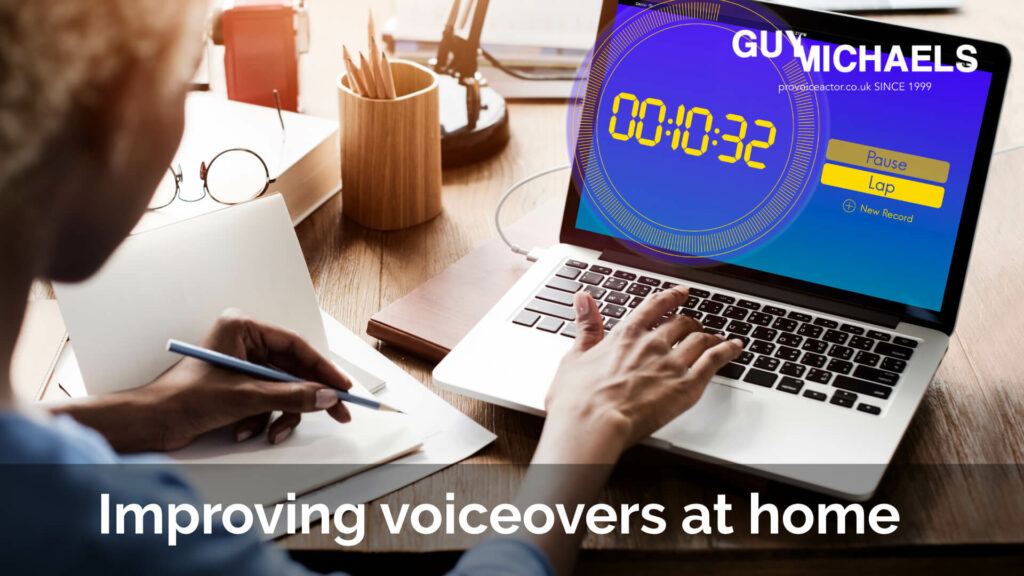Do you need some advice on recording voiceovers?
Of course, I’ll always argue that booking a professional voice-over artist is the way to go if you want to elevate your brand, product, or service, but there are times when you might need to record your own. Perhaps it’s due to budgetary or time constraints or you need to record a ‘scratch demo’ to provide to the pro voice actor to help with their delivery.
No matter, there are always a few simple things you can do to improve recording voiceovers in-house.
Please note that these tips are not aimed at professional voiceover artists but instead they are to help content creators or small businesses who want to enhance the quality when recording voiceovers.
1 – Invest in the right gear: Even a basic USB microphone can deliver significantly better results than your built-in computer mic. Consider getting a pop filter to minimize those distracting ‘plosive’ sounds.
2 – Use recording software: Free options like Audacity offer basic editing and noise reduction, making your voice-overs sound cleaner.
3 – Warm up your voice: Start with humming or tongue-twisters. Think of them as vocal stretches before a recording session workout!

4 – Relax and breathe: Drop your shoulders, take deep calm breaths, and smile to naturally improve the tone of your voice.
5 – Jaw exercises: A relaxed jaw is key to a clear recording. Gently massage your jawline to release tension.
6 – Read the script out loud a few times before recording: Familiarise yourself with the text and smooth out any awkward phrasing. Use my words to time calculator to help with pacing.
7 – Stay hydrated: Keep sipping water to lessen mouth clicks picked up by the mic and keep your brain on point.
8 – Clear enunciation: Speak naturally, but make sure your words are distinct and easy to understand.

9 – Adjust your pacing: Change the speed and rhythm of your delivery to emphasise key points or create a sense of urgency.
10 – Consider your audience: If your audience isn’t made up of native English speakers, adjust your pace and clarity accordingly.
11 – Test recordings: Listen back to identify areas for improvement. Don’t get discouraged – we often dislike our recorded voices at first!
12 – Take regular breaks: Recording voice-overs takes focus. Short recording sessions will help maintain quality.
Here are some tips I put together in a short video on home studio voice over recording: VOICEOVER STUDIO TIPS
More on recording voiceovers
Want to elevate those voiceover recordings?
The Basics
Probably the first and most important consideration when recording voiceovers, is the environment you plan to record in. Start with your environment. Find a quiet space with minimal echo – a few soft furnishings will help minimize the sound of reflections. Next, invest in a quality microphone. Even a simple USB mic offers better audio quality than your built-in computer microphone. Consider a pop filter to reduce distracting pops and plosives.
Setup and Delivery
Optimize your microphone placement to find the best sound. Experiment with the distance, but around 6-12 inches away is a starting point. Before you start recording, do simple vocal exercises to warm up your voice, giving you a smoother delivery. Throughout your recording session, remember to take deep breaths for a calm, clear tone and stay hydrated to avoid those clicking mouth sounds.
Strive for Clarity
Speak clearly, but don’t overdo the enunciation – aim for a natural, easy-to-understand sound. A professional voice actor knows the importance of tailoring the delivery to the type of voice recording you’re creating and the intended audience. This includes adjusting your tone of voice and pacing to fit the project and connect with listeners.
Editing is Key
Even the best voice-over needs a little polish. Get comfortable with audio recording software so you can fix mistakes, remove background noises, and give your recording a professional touch. Always do a test recording to check the sound quality, adjust your settings and ensure everything works smoothly before a full recording session.
The next level
Ready to take your recordings to the next level? If you’re serious about voice-overs, consider investing in an audio interface and an XLR microphone for improved audio quality of a recording. Learn about different microphone types, like condenser mics or dynamic mics, to understand how they capture sound differently. Listen to your recorded voice through good headphones or speakers; this helps you identify any subtle audio issues you might have missed.
Again, these tips are not for professional voice actors recording voiceovers but instead they are just to help you in your small business or perhaps you are a solo entrepreneur recording a podcast or a simple explainer video for your product.
For a professional voiceover recording in a state-of-the-art dedicated voiceover recording studio, drop me a line!
